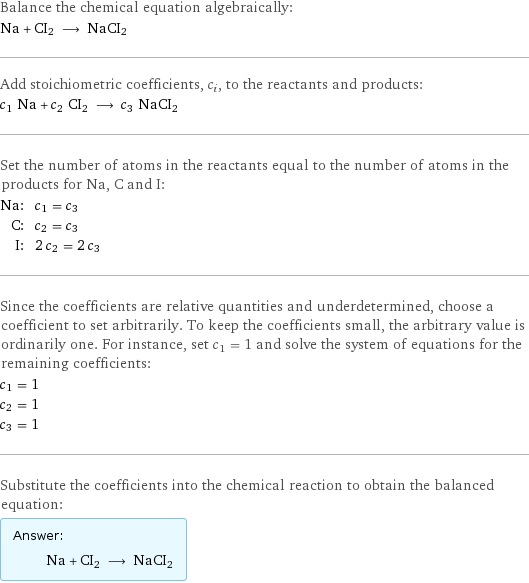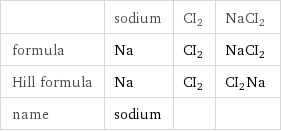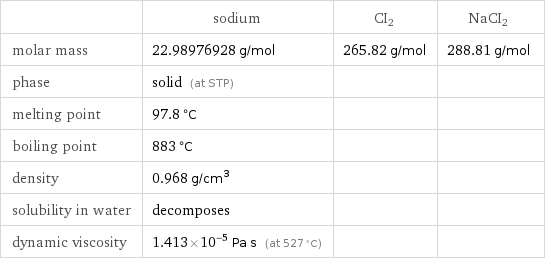Input interpretation

Na sodium + CI2 ⟶ NaCI2
Balanced equation

Balance the chemical equation algebraically: Na + CI2 ⟶ NaCI2 Add stoichiometric coefficients, c_i, to the reactants and products: c_1 Na + c_2 CI2 ⟶ c_3 NaCI2 Set the number of atoms in the reactants equal to the number of atoms in the products for Na, C and I: Na: | c_1 = c_3 C: | c_2 = c_3 I: | 2 c_2 = 2 c_3 Since the coefficients are relative quantities and underdetermined, choose a coefficient to set arbitrarily. To keep the coefficients small, the arbitrary value is ordinarily one. For instance, set c_1 = 1 and solve the system of equations for the remaining coefficients: c_1 = 1 c_2 = 1 c_3 = 1 Substitute the coefficients into the chemical reaction to obtain the balanced equation: Answer: | | Na + CI2 ⟶ NaCI2
Structures

+ CI2 ⟶ NaCI2
Names

sodium + CI2 ⟶ NaCI2
Equilibrium constant
![Construct the equilibrium constant, K, expression for: Na + CI2 ⟶ NaCI2 Plan: • Balance the chemical equation. • Determine the stoichiometric numbers. • Assemble the activity expression for each chemical species. • Use the activity expressions to build the equilibrium constant expression. Write the balanced chemical equation: Na + CI2 ⟶ NaCI2 Assign stoichiometric numbers, ν_i, using the stoichiometric coefficients, c_i, from the balanced chemical equation in the following manner: ν_i = -c_i for reactants and ν_i = c_i for products: chemical species | c_i | ν_i Na | 1 | -1 CI2 | 1 | -1 NaCI2 | 1 | 1 Assemble the activity expressions accounting for the state of matter and ν_i: chemical species | c_i | ν_i | activity expression Na | 1 | -1 | ([Na])^(-1) CI2 | 1 | -1 | ([CI2])^(-1) NaCI2 | 1 | 1 | [NaCI2] The equilibrium constant symbol in the concentration basis is: K_c Mulitply the activity expressions to arrive at the K_c expression: Answer: | | K_c = ([Na])^(-1) ([CI2])^(-1) [NaCI2] = ([NaCI2])/([Na] [CI2])](../image_source/861138d4c71a7641f7284b68cd2873e9.png)
Construct the equilibrium constant, K, expression for: Na + CI2 ⟶ NaCI2 Plan: • Balance the chemical equation. • Determine the stoichiometric numbers. • Assemble the activity expression for each chemical species. • Use the activity expressions to build the equilibrium constant expression. Write the balanced chemical equation: Na + CI2 ⟶ NaCI2 Assign stoichiometric numbers, ν_i, using the stoichiometric coefficients, c_i, from the balanced chemical equation in the following manner: ν_i = -c_i for reactants and ν_i = c_i for products: chemical species | c_i | ν_i Na | 1 | -1 CI2 | 1 | -1 NaCI2 | 1 | 1 Assemble the activity expressions accounting for the state of matter and ν_i: chemical species | c_i | ν_i | activity expression Na | 1 | -1 | ([Na])^(-1) CI2 | 1 | -1 | ([CI2])^(-1) NaCI2 | 1 | 1 | [NaCI2] The equilibrium constant symbol in the concentration basis is: K_c Mulitply the activity expressions to arrive at the K_c expression: Answer: | | K_c = ([Na])^(-1) ([CI2])^(-1) [NaCI2] = ([NaCI2])/([Na] [CI2])
Rate of reaction
![Construct the rate of reaction expression for: Na + CI2 ⟶ NaCI2 Plan: • Balance the chemical equation. • Determine the stoichiometric numbers. • Assemble the rate term for each chemical species. • Write the rate of reaction expression. Write the balanced chemical equation: Na + CI2 ⟶ NaCI2 Assign stoichiometric numbers, ν_i, using the stoichiometric coefficients, c_i, from the balanced chemical equation in the following manner: ν_i = -c_i for reactants and ν_i = c_i for products: chemical species | c_i | ν_i Na | 1 | -1 CI2 | 1 | -1 NaCI2 | 1 | 1 The rate term for each chemical species, B_i, is 1/ν_i(Δ[B_i])/(Δt) where [B_i] is the amount concentration and t is time: chemical species | c_i | ν_i | rate term Na | 1 | -1 | -(Δ[Na])/(Δt) CI2 | 1 | -1 | -(Δ[CI2])/(Δt) NaCI2 | 1 | 1 | (Δ[NaCI2])/(Δt) (for infinitesimal rate of change, replace Δ with d) Set the rate terms equal to each other to arrive at the rate expression: Answer: | | rate = -(Δ[Na])/(Δt) = -(Δ[CI2])/(Δt) = (Δ[NaCI2])/(Δt) (assuming constant volume and no accumulation of intermediates or side products)](../image_source/9b3382f6a003cbf3d5f14047a5a81886.png)
Construct the rate of reaction expression for: Na + CI2 ⟶ NaCI2 Plan: • Balance the chemical equation. • Determine the stoichiometric numbers. • Assemble the rate term for each chemical species. • Write the rate of reaction expression. Write the balanced chemical equation: Na + CI2 ⟶ NaCI2 Assign stoichiometric numbers, ν_i, using the stoichiometric coefficients, c_i, from the balanced chemical equation in the following manner: ν_i = -c_i for reactants and ν_i = c_i for products: chemical species | c_i | ν_i Na | 1 | -1 CI2 | 1 | -1 NaCI2 | 1 | 1 The rate term for each chemical species, B_i, is 1/ν_i(Δ[B_i])/(Δt) where [B_i] is the amount concentration and t is time: chemical species | c_i | ν_i | rate term Na | 1 | -1 | -(Δ[Na])/(Δt) CI2 | 1 | -1 | -(Δ[CI2])/(Δt) NaCI2 | 1 | 1 | (Δ[NaCI2])/(Δt) (for infinitesimal rate of change, replace Δ with d) Set the rate terms equal to each other to arrive at the rate expression: Answer: | | rate = -(Δ[Na])/(Δt) = -(Δ[CI2])/(Δt) = (Δ[NaCI2])/(Δt) (assuming constant volume and no accumulation of intermediates or side products)
Chemical names and formulas

| sodium | CI2 | NaCI2 formula | Na | CI2 | NaCI2 Hill formula | Na | CI2 | CI2Na name | sodium | |
Substance properties

| sodium | CI2 | NaCI2 molar mass | 22.98976928 g/mol | 265.82 g/mol | 288.81 g/mol phase | solid (at STP) | | melting point | 97.8 °C | | boiling point | 883 °C | | density | 0.968 g/cm^3 | | solubility in water | decomposes | | dynamic viscosity | 1.413×10^-5 Pa s (at 527 °C) | |
Units
